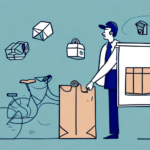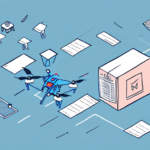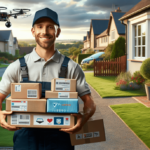How Customers Can Take Control of E-Commerce Deliveries
With the rapid growth of e-commerce, shopping for goods and services online has become more convenient than ever. The ability to shop from home and have products delivered to your doorstep is a major advantage for many customers. However, the delivery process can be complex, and customers may encounter a range of challenges along the way. This guide explores how customers can take control of their e-commerce deliveries to enhance their shopping experience.
Overview of the E-Commerce Delivery Process
The journey of an online order typically begins when a customer places an order on an online store. The order is then processed by the retailer, which may include quality checks, packaging, and arranging for shipment. A shipping provider subsequently takes over, transporting the package to the customer’s address.
Once the package is in transit, customers can usually track its progress through the shipping provider’s website or app. This tracking capability allows customers to anticipate delivery times and plan accordingly. In some instances, shipping providers offer options to redirect the package to a different address or to a designated pickup location.
After delivery, customers may be prompted to provide feedback on their delivery experience. This feedback is valuable for retailers and shipping providers to improve their services and ensure smoother future deliveries.
Common Challenges Faced by Customers in E-Commerce Deliveries
Delayed Deliveries and Lost Packages
Despite the convenience of e-commerce, delays in delivery and lost packages are common issues that frustrate customers. According to a Statista report, about 30% of online shoppers have experienced delayed deliveries. These delays can disrupt customer plans and reduce satisfaction.
Incorrect Addressing and Delivery Errors
Incorrect addressing can lead to delivery failures, requiring customers to coordinate with retailers and shipping providers to rectify the issue. This not only causes inconvenience but can also result in additional delivery fees.
Damaged or Broken Products
Receiving damaged or broken products is another significant challenge. Inadequate packaging or mishandling during transit can lead to product damage, necessitating returns and replacements that are time-consuming and frustrating for customers.
Misleading Product Descriptions
Sometimes, discrepancies between product descriptions or images and the actual product received can lead to disappointment. Ensuring accurate product representation is crucial for maintaining customer trust and satisfaction.
Why Taking Control of Your E-Commerce Deliveries is Important
Enhancing Delivery Tracking
By proactively managing deliveries, customers can track their packages in real-time. This allows for monitoring the delivery progress and receiving updates on any changes in the delivery schedule. Real-time tracking can be particularly useful for arranging to be present for the delivery or rescheduling it for a more convenient time.
Avoiding Missed Deliveries
Taking control helps in avoiding missed deliveries. Proactive delivery management ensures that customers are available to receive their packages, saving time and avoiding additional delivery fees or the need to collect packages from delivery depots.
Improving Overall Shopping Experience
When customers manage their deliveries effectively, it streamlines the entire shopping process, leading to a more satisfactory experience. This proactive approach minimizes potential complications and enhances the reliability of e-commerce deliveries.
Strategies to Manage E-Commerce Deliveries Effectively
Understanding Your Delivery Options
Different retailers and shipping providers offer various delivery options, such as standard delivery, expedited shipping, same-day delivery, and in-store pickup. Understanding these options helps customers choose the most suitable method based on their needs and urgency.
- Standard Delivery: Typically takes 3-5 business days and is the most cost-effective option.
- Expedited Shipping: Guarantees delivery within 1-2 business days at a higher cost.
- Same-Day Delivery: Available in select areas and ensures delivery on the same day of the order.
- In-Store Pickup: Allows customers to collect their orders from a nearby store, enhancing convenience.
Effective Tracking of Deliveries
Most retailers and shipping providers offer tracking services that allow customers to monitor their packages throughout the delivery process. Utilizing these tracking tools helps customers stay informed about their delivery status and anticipate arrival times.
However, it's important to recognize that tracking information may sometimes be inaccurate due to factors like weather conditions or logistical issues. In such cases, contacting the retailer or shipping provider for updates is advisable.
Communicating with Retailers and Delivery Companies
Effective communication is key to resolving any issues that may arise during the delivery process. Customers should promptly reach out to retailers or shipping providers if they encounter problems like missing packages or delays.
- Use online chat support, phone lines, or email to communicate issues.
- Keep records of all communications, including dates, times, and representative names.
- Maintain a polite and respectful tone to facilitate quicker and more efficient resolutions.
Managing Delivery Expectations
Setting realistic expectations about delivery times and understanding the reliability of delivery partners are essential for a positive shopping experience. Customers should choose delivery options that align with their schedules and preferences.
Retailers can also assist by providing accurate estimated delivery times through automated notifications, reducing the likelihood of complaints due to unexpected delays.
Technological Innovations in E-Commerce Deliveries
Drone Deliveries
Drone technology is revolutionizing e-commerce deliveries by enabling faster delivery times, especially in urban areas. Companies like Amazon are piloting drone delivery services to enhance efficiency and reduce delivery times.
Smart Sensors and IoT
Smart sensors and the Internet of Things (IoT) are being integrated into delivery systems to provide real-time alerts and updates. These technologies help customers track their packages more accurately and ensure timely deliveries.
Automated Warehousing
Automation in warehouses streamlines the order fulfillment process, reducing the time from order placement to shipment. This results in faster delivery times and improved accuracy in order processing.
Sustainable Packaging Solutions
Innovations in sustainable packaging are addressing environmental concerns by reducing waste and using eco-friendly materials. This not only benefits the environment but also appeals to eco-conscious customers.
Future Trends in E-Commerce Deliveries and Their Impact on Customers
Growth of Same-Day and Next-Day Delivery Services
The demand for faster delivery times is driving the expansion of same-day and next-day delivery services. This trend enhances customer satisfaction by providing greater convenience and flexibility in receiving orders.
Eco-Friendly and Sustainable Delivery Options
With increasing awareness of environmental issues, there is a growing focus on eco-friendly delivery options. Customers are favoring retailers that offer sustainable packaging and carbon-neutral delivery services.
Increased Use of Artificial Intelligence
Artificial Intelligence (AI) is being utilized to optimize delivery routes, predict demand, and enhance customer service through chatbots and virtual assistants. AI-driven solutions improve efficiency and provide a more personalized shopping experience.
Integration of Augmented Reality (AR) in Delivery Planning
Augmented Reality (AR) is being integrated into delivery planning to help customers visualize package placements and optimize space in their homes. This technology aids in better planning and reduces the chances of package misplacement.
Conclusion
E-commerce deliveries offer immense convenience, but the process can be fraught with challenges. By taking control of their delivery management, customers can mitigate potential issues and enhance their overall shopping experience. Key strategies include understanding delivery options, tracking packages effectively, maintaining clear communication with retailers and delivery companies, and staying informed about technological innovations and future trends. Embracing these practices ensures that e-commerce deliveries are reliable, efficient, and aligned with customer expectations.






















